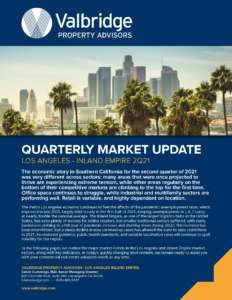2Q 2021 Market Trends Newsletter
July 29, 2021
LOS ANGELES-INLAND EMPIRE 2Q21
The economic story in Southern California for the second quarter of 2021 was very different across sectors: many areas that were once projected to thrive are experiencing extreme tension, while other areas regularly on the bottom of their competitive markets are climbing to the top for the first time. Office space continues to struggle, while industrial and multifamily sectors are performing well. Retail is variable, and highly dependent on location.
The metro Los Angeles economy continues to feel the effects of the pandemic: unemployment rates, which improved in late 2020, largely held steady in the first half of 2021, keeping unemployment in L.A. County at nearly double the national average. The Inland Empire, as one of the largest logistics hubs in the United States, has seen plenty of success for online retailers, but smaller traditional sectors suffered, with many businesses yielding a full year of pandemic stresses and shutting down during 20Q2. The recovery has been intermittent, but a sharp decline in new coronavirus cases has allowed the state to ease restrictions in 2021. Inconsistent guidance, public health standards, and variable vaccination rates will continue to spell volatility for the region.
Below, we outline the major market trends in four critical Los Angeles and Inland Empire market sectors, along with key indicators. For a full analysis, including critical charts, graphs, and a deep dive on supply chain challenges, download the PDF copy. In today’s quickly changing environment, we remain ready to assist you with your commercial real estate valuation needs at any time.
LOS ANGELES INDUSTRIAL REAL ESTATE TRENDS
- The Los Angeles industrial sector continues to have one of the lowest vacancy rates nationally, and rental rates, which have been increasing for over a decade, continue to reach new highs.
- It is likely that industrial conditions in L.A. will remain favorable to landlords, as vacancies are anticipated to trend downward for at least the near term.
- Asking rents for industrial spaces in L.A. continue to rise, but less sharply than in prior years. Annual rent growth presently stands at 5.7%, compared to 5.4% nationally.
- High construction costs and limited land keep most new builds in the Inland Empire; however, there is a large mixed-use project underway next to the Hollywood Burbank Airport
INLAND EMPIRE INDUSTRIAL REAL ESTATE TRENDS
- The vacancy rate of the Inland Empire Industrial sector remains at a solid 2.9%.
- Since the beginning of the year rent rates have quickly increased to 9.1%, yet are still regionally very competitive, at one-third the rates in surrounding markets.
- Since 4Q20, capital flow in this sector has been on the rise: while institutional, public REIT, and private equity investors have pulled back from acquiring new properties, a $1.5 billion recapitalization deal between Blackstone REIT and LBA Realty (closed in January 2021) involves many major IE industrial properties.
- Leasing continues to rise, with the help of e-commerce and logistics companies contributing over a quarter of volume – most industrial spaces continue to be best suited to large-scale enterprises.
LOS ANGELES OFFICE REAL ESTATE TRENDS
- The Los Angeles office sector continues to see hard times: asking rates are continuing to decline at the fastest rate seen since 2010 when rent growth was steadily increasing as high as 8.5% year over year.
- Los Angeles office sales are well under the market average of $7.1 billion annually, but there is hope for growth with recent evidence showing some investors are willing to pay normal rates.
- Rates are continuing to decrease since the last increase seen at the beginning of 2020. The market vacancy remains at 13.6%, the highest rate since 1996.
- The market has not seen such a negative net absorption in over a decade.
INLAND EMPIRE OFFICE REAL ESTATE TRENDS
- Most leases in the Inland Empire market are small and medium sized office spaces: leasing activity is low but has remained low since two years before the pandemic began.
- Because the tenancy base in the IE is driven by firms and government establishments, it has seen less pandemic-related impact and fewer swings over the past year.
- Medical office facilities represent one of the fastest-growing submarkets in the IE: in May of 2021, a private investor acquired the 56,800 sq. ft. Inland Medical Center in Wildomar for $18 million ($317/SF). The property is occupied by Kaiser Permanente and City of Hope and traded at a 7.4% cap rate. Riverside University Health System, the Corona Regional Medical Campus, City of Hope, and Kasier Permanente have all leased substantial spaces scheduled for 2021 deliveries.
LOS ANGELES RETAIL REAL ESTATE TRENDS
- Normalcy is on the horizon for the Los Angeles retail sector in many ways as businesses begin to re-open and operate under regular capacity.
- A regular trend before the pandemic of retail closures was only heightened by the pandemic and is currently the highest it has been in 7 years at 5.5%.
- Los Angeles retail asking rates remain -1.8% below 2Q20, with strip and neighborhood centers experiencing the slowest decline.
- Property sales through the past year are near pre-pandemic numbers at $4.0 billion, most of the dollars coming from the first half of 2020.
INLAND EMPIRE RETAIL REAL ESTATE TRENDS
- The Inland Empire retail sector is experiencing one of the highest vacancy rates in the nation as compared to other metro areas with populations over one million.
- As consumer trends continue to move toward e-commerce, rents grew 3.1% over the past year because of many store closures.
- The Inland Empire is experiencing the benefits of offering lower-risk investment options as investors have continued to show interest in low-cap rate deals even through the pandemic.
- Price appreciation has been positive despite the limited rent gains and high vacancies with the market price growing 3% since 2Q20.
LOS ANGELES MULTIFAMILY HOUSING REAL ESTATE TRENDS
- The Los Angeles multifamily sector is recovering from the pandemic at a slower pace than the national average by four months.
- Market vacancies remain 1.0% higher than the metro average, but have seen a decrease of 0.8% from last year’s record high of 6.2%.
- The multifamily sector experienced a significant impact from the pandemic, with asking rates continuing to suffer at 2.4%
below the national 7.3% average. - Sales volumes are slowly returning to pre-pandemic numbers as there was a surge of activity during 4Q20. After prices flatlined at the end of 2020, they are slowly yet consistently appreciating since the beginning of 2021.
INLAND EMPIRE MULTIFAMILY HOUSING REAL ESTATE TRENDS
- The Inland Empire multifamily sector has experienced rent gains during the past twelve months as HCOL area residents move to the IE to save money.
- Vacancies are lower than the Inland Empire has experienced in years and are projected to remain 2.5% below the national average for the next five years.
- Over the past year, rent gains have exceeded projected growth by growing 14.1%. With job growth increasing, workers are moving from surrounding areas into the Inland Empire boosting the rent gains 14.1%, a level far beyond the projected rate.
- Many outsized sales closed in the second half of 2020, but sales activity remains negatively impacted by the pandemic.
For more, including a deep dive into supply chain challenges, DOWNLOAD FULL REPORT HERE.
MORE RECENT LOCAL MARKET ANALYSIS FROM VALBRIDGE PROPERTY ADVISORS LOS ANGELES-INLAND EMPIRE
- Right of Way Appraisals »
- Gifts and Future Tax Code Changes »
- Assessing Risk to Commercial Property »



